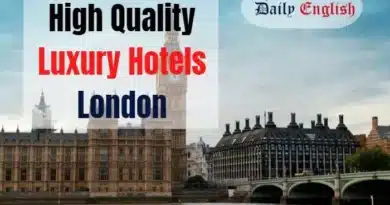Currently, Clarence House functions as the London abode for King Charles III and Queen Camilla. Since 2003, it has been Kng Charles’s primary residence. Before that, from 1953 to 2002, it housed Queen Elizabeth The Queen Mother. Before her tenure, it served as the official residence for her daughter, Princess Elizabeth, who would later become Queen Elizabeth II.
I. Introduction
A. A Brief History of British Royal Residences
The story of British royal residences is a fascinating tapestry woven with threads of history, grandeur, and changing needs. For centuries, monarchs have occupied various palaces and castles throughout the United Kingdom, each serving a distinct purpose.
Early on, residences like Windsor Castle served as fortified strongholds, offering protection during turbulent times. As the monarchy evolved, palaces like Hampton Court emerged, showcasing architectural magnificence and reflecting the growing power of the Crown. London became a central stage, with palaces like St. James’s serving as administrative centres and Buckingham Palace eventually taking centre stage.
B. The Significance of the Monarch’s Residence
The monarch’s residence is more than just a place to live; it’s a potent symbol. It embodies the continuity and tradition of the monarchy, serving as a focal point for national identity and a backdrop for official ceremonies. The residence’s grandeur reflects the prestige of the Crown. At the same time, its location can signal a connection to the people or a strategic position of power. Choosing a residence, therefore, is a weighty decision fraught with symbolism and practicality.
II. King Charles III’s Current Residence

A. Clarence House: A Historical Overview
King Charles III resides at Clarence House, a grand residence on The Mall in London. Steeped in history, Clarence House boasts a rich past that intertwines with the lives of several British monarchs.
1. Construction and Early Residents
In the early 19th century, Clarence House was originally designed for Prince William, Duke of Clarence (later King William IV). The Georgian architecture reflects the popular style of the era, and the house has undergone several renovations throughout its history. Early residents included Queen Adelaide, wife of William IV, and Princess Victoria, who famously held her first Privy Council meeting after ascending the throne.
2. Clarence House in the 20th Century
The 20th century saw Clarence House become a home for various members of the Royal Family. Queen Mary, wife of King George V, used it extensively, and later, it became the official residence of Queen Elizabeth The Queen Mother. Following her passing in 2002, extensive renovations were undertaken before Prince Charles (now King Charles III) moved in in 2003.
Also, read:
- State Apartments at Windsor Castle: An Ultimate Guide.
- St. George’s Chapel at Windsor Castle in History & Today.
- Queen Mary’s Dollhouse at Windsor Castle.
B. Reasons for Choosing Clarence House
There could be several reasons why Clarence House might be chosen as a residence over Buckingham Palace:
- Personal Preference and Familiarity: The royals residing there might prefer Clarence House. It’s a smaller and more manageable property than Buckingham Palace, and royals who have previously spent time there might feel comfort and familiarity.
- Size and Suitability for a Modern Monarch: Clarence House’s size might better suit a modern monarchy. Upkeep of a massive palace like Buckingham Palace can be pretty expensive. While still grand, Clarence House offers a more manageable living space.
- Renovation Plans for Buckingham Palace: Buckingham Palace might be undergoing renovations that make it unsuitable for residence. Extensive renovations can be disruptive and make living there impractical.
Considering these reasons, we can better understand why Clarence House might be chosen as a royal residence.
Also, read:
III. Buckingham Palace: The Traditional Royal Residence
Buckingham Palace, a majestic landmark in the heart of London, has been the primary residence of British monarchs for almost two centuries. Its imposing facade and sprawling grounds are instantly recognisable symbols of the British Crown.
A. History of Buckingham Palace as a Royal Residence
Initially a grand townhouse built for the Duke of Buckingham in the 18th century, Buckingham Palace underwent significant transformations to become a fit dwelling for royalty. King George III acquired it in 1761 for his wife, Queen Charlotte, and extensive renovations followed under the reigns of George IV and Queen Victoria. These renovations expanded the house into a grand palace, complete with State Rooms for official functions and private apartments for the Royal Family. Queen Victoria officially became the first monarch to reside there in 1837.
Also, read:
- How Far is Windsor Castle from Buckingham Palace? Royal Mile?
- How to Get to the Windsor Castle from London
- Who Lives in the Windsor Castle?
B. Buckingham Palace: Advantages and Challenges
Buckingham Palace offers several advantages as a royal residence. Its grand scale provides ample space for state functions, official ceremonies, and housing visiting dignitaries. The location in central London places the monarch at the heart of the nation’s capital. However, the palace also presents some challenges. Its vast size can feel impersonal for a modern monarch seeking a more comfortable living environment. Upkeep and security for such a sprawling complex can be demanding.
IV. The Future of King Charles III’s Residence

The question of where King Charles III will reside in the long term remains a topic of public interest. Two main possibilities are on the table: a potential move to Buckingham Palace after ongoing renovations or continued use of Clarence House.
A. Potential Move to Buckingham Palace
1. Completion of Renovations
Buckingham Palace is undergoing significant renovations, which are expected to be completed in the late 2020s. These renovations aim to modernise the palace infrastructure, improve security measures, and create a more comfortable living space for the Royal Family. Once completed, Buckingham Palace might regain its allure as the primary royal residence.
2. Shifting Priorities and Public Perception
King Charles III, known for his interest in sustainability and a less formal approach to monarchy, may see Buckingham Palace’s grand scale as somewhat excessive. However, a move to the palace could be seen as a return to tradition and a symbol of unity for the nation. Imagine the iconic balcony appearances at Buckingham Palace, a familiar image for Britons and a powerful visual for the world.
Also, read:
- Are Babies Free for Windsor Castle
- Are Dogs Allowed into Windsor Castle
- Comparing Shops Near Windsor Castle
B. Possible Long-Term Use of Clarence House
1. Working Royal Residence
With its smaller size and more manageable upkeep, Clarence House could continue to serve as King Charles’ preferred residence. It provides a comfortable living space suitable for official meetings and audiences. It is a more practical option for a modern monarch with a busy schedule.
2. Private Residence for the King
Another possibility is that Clarence House becomes a dedicated private residence for the King and Queen Camilla, separate from the working royal residence. This separation could allow for a more apparent distinction between the King’s official duties and personal life.
V. Conclusion: King Charles III’s Residence – A Reflection of Modern Monarchy

The choice of residence for King Charles III reflects the ongoing evolution of the British monarchy. With its grandeur and history, Buckingham Palace embodies tradition and national identity. Clarence House, on the other hand, offers a more manageable and modern living space. The decision ultimately hinges on King Charles’ personal preferences and his vision for a monarchy fit for the 21st century.
A. A King for a Changing World
Monarchy, like any institution, needs to adapt to remain relevant. King Charles’ choice of residence, whether Buckingham Palace or Clarence House, sends a subtle message. A move to Buckingham Palace could signify a commitment to tradition and a desire to project an image of stability and unity for the nation. On the other hand, staying at Clarence House suggests a preference for a more modest and approachable monarchy. Think about it – a King who chooses comfort over grandeur might be seen as someone in touch with the realities of his people’s lives.
B. More Than Bricks and Mortar
Ultimately, the King’s residence is just one facet of a much larger conversation about the monarchy’s role in modern Britain. The decision of where to live reflects a broader desire to shape the monarchy for the future. A king who keeps an eye on tradition while embracing practicality is what the monarchy needs in this ever-changing world.
Also, read:
- The Mystery of 2 Windsor Castles
- Are There Guided Tours of Windsor Castle
- Are There Mice in Windsor Castle
VI. FAQs
1. What role does the monarch’s choice of residence play in public perception and royal duties?
The monarch’s choice of residence can influence public perception. A smaller residence like Clarence House might project a more approachable image, while Buckingham Palace emphasises grandeur and tradition. Duties are fulfilled regardless of location, but official ceremonies and significant events are usually held at Buckingham Palace.
2. How do Clarence House and Buckingham Palace compare operational costs and security needs?
Clarence House is significantly cheaper to maintain than the vast Buckingham Palace. Security needs are also scaled to the size and importance of each residence.
3. What historical events have taken place at Clarence House and Buckingham Palace?
Clarence House has been home to several monarchs and their families. Buckingham Palace has witnessed state visits, coronations, and even WWII bombings.
4. Are there any plans to open more of Clarence House or Buckingham Palace to the public?
Both palaces have areas open to the public. Still, Buckingham Palace offers more extensive tours due to its size and historical significance. There are no current plans for significant expansions of public access.
5. How do environmental sustainability efforts compare between the two residences?
Clarence House is likely more energy-efficient due to its smaller size. Buckingham Palace undertakes sustainability initiatives like installing solar panels and improving heating systems.
Also, read:
- Are There Stables at Windsor Castle
- Are There Steps, Elevators or Lifts in Windsor Castle
- Are There Women in the Coldstream Guards at Windsor Castle
6. What are the implications of King Charles III’s residence choice on the future of the monarchy?
King Charles’ preference for Clarence House might signal a future monarchy prioritising practicality and cost-consciousness. However, Buckingham Palace will likely remain a crucial venue for state occasions.
7. How have renovations to Buckingham Palace impacted its role as a royal residence?
Buckingham Palace’s ongoing renovations limit its functionality as a residence for now. This might lead to a more shared-use model, with the working monarch residing elsewhere.










Comments are closed.